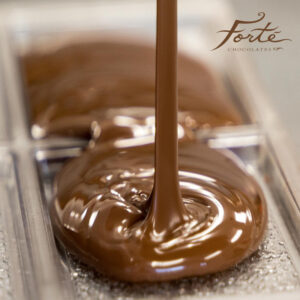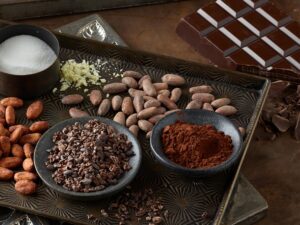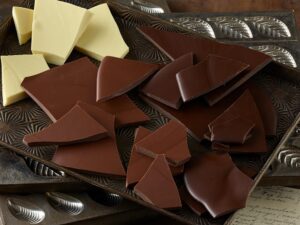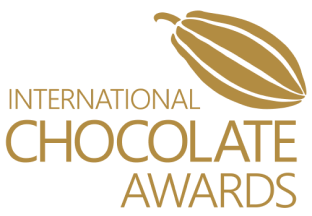Types of Chocolate: Just The Basics
Types of Chocolate: Just The Basics
The world of chocolate has expanded quickly over the past 10+ years. With so many options readily available it can seem like a daunting task when it comes to selecting the best chocolate to use. Don’t worry! It is much simpler when you know the kinds of chocolate and what to look for. Chocolate products keep for a very long time so I recommend buying several types and let your taste buds lead the way.
Some of my favorite quality chocolate brands include Gusto Chocolates, Felchlin, Valrhona, Scharffen Berger, Dick Taylor, and of course Forte Chocolates.

Dark chocolate has so many wonderful flavors that come naturally from the bean and can change based on the terroir of where it was grown. It’s intense flavor is perfect for most recipes, especially cream-based truffles. Dark chocolate is comprised of cocoa mass (ground up cacao beans) and sugar but may also contain additional cocoa butter, an emulsifier (such as soy lecithin) to help keep the texture smooth, and often contains vanilla as well.
Dark chocolate has between 35% – 99% cocoa content, but this can vary drastically. Chocolate that is labeled extra dark or bittersweet chocolate generally has 65%-85% cocoa and will be on the bitter side as it contains less sugar. Semisweet chocolate contains added sugar with cocoa percentages typically in the 35%-65% range.
Whatever percentage you choose, be sure to taste the chocolate to make sure you personally enjoy it. If you bought 20 different bars all with 70% cocoa content, they may taste different from one another and will change the flavor of the confection that you are making quite a bit. I personally love experimenting with the different makers, origins, percentages, and combining a few to make something new.
Unsweetened chocolate is made from ground up beans only. No sugar is added, therefore it has 100% cocoa content. This is what baking chocolate originally referred too. Technically 100% cocoa is not legally considered chocolate as chocolate must contain at least 1% sugar but the lack of sugar does not change how it will temper or handle Use unsweetened cocoa whenever you want an intense chocolate flavor with less sugar.
Milk chocolate is the most common type of eating chocolate worldwide. Its cocoa content typically ranges from 30%-45% and it contains the same ingredients as dark chocolate, with the addition of milk powder. The milk displaces part of the cocoa mass in the chocolate, so the result tastes sweeter, creamier, and is less bitter as a result.
Dark Milk: This is a milk chocolate that has extra cacao mass and it generally has a darker color than typical milk chocolate. Think of this as a mix of milk and dark chocolate.
White Chocolate is just like milk chocolate, but it is sweeter and has a cream color instead of being brown as it lacks cocoa solids. White chocolate is the perfect choice awesome for making butter truffles and for adding decoration to milk/dark chocolate treats.
While some may not think of white chocolate as being “real” chocolate, this topic has come under debate over recent years. Not only does it have a long standing place in the industry, it follows all of the rules of chocolate in regards to mouthfeel/texture, flavor delivery, and workability as white chocolate contains a lot of cocoa butter. White chocolate is a great base to work with when adding savory flavors like rosemary and sea salt because it has subtle flavors that won’t clash with the added flavors.
There are plenty of fake white chocolates out there so look for cocoa butter to be one of the first 2 ingredients on the label. Legitimate white chocolate contains at least 20% cocoa butter, but look for the varieties that have closer to 30% cocoa butter as they are much smoother, have a cleaner flavor, and are easier to work with.
Other chocolate terms that you may see are:

Cacao Beans, Cocoa Beans, Nibs: Beans that are found within the football-shaped fruit (cacao pods) of the Theobroma cacao, a tree native to the tropical Amazon forests. This is where chocolate comes from. Broken up cacao beans are called nibs.
% Cacao: The % of cacao or cocoa refers to the total percentage of the bar that came from the bean and includes cocoa mass and cocoa butter.
Chocolate Liquor, Cocoa Mass, Cocoa Paste: Cacao beans that have been roasted (typically), ground up, and refined to paste. This is the same as unsweetened chocolate as no sugar was added. Even though the term chocolate or cocoa liquor, no alcohol is included.
Cocoa Butter: Cocoa butter is the fat naturally present within cacao beans. It is a light yellow color, hence the name, but it contains no dairy. Cocoa butter melts just below body temperature, giving chocolate its unique mouthfeel, shine, and strength.
Cocoa Powder and Cocoa Solids: The solid part of the cocoa bean (the brown stuff). When cacao beans are crushed the resulting paste a.k.a. chocolate liquor, can be pressed under high pressure to remove the fat. When the resulting pressed cake is broken up into a powder, it is called cocoa powder or natural cocoa. Cocoa powder is what is used to make hot cocoa drinks.

Couverture Chocolate: Couverture literally means “to cover”. This chocolate has extra cocoa butter in it so that the chocolate is not as thick. This makes it easier to cover items like sea salt caramels, cookies, and marshmallows with a thin layer of chocolate. Most chocolate bars and larger bars known as baking blocs are couverture chocolate.
Coating chocolate (aka Almond Bark) is not actually chocolate as it contains vegetable fats like palm kernel oil instead of cocoa butter. This is often called fake or imitation chocolate. It is the sweetest of all the options and generally used because it is inexpensive and doesn’t require tempering. Almond bark is great for kid treats and as a backup plan if tempering is not your thing.
Karen Neugebauer is internationally recognized as being one of the best chocolatiers in the artisan chocolate industry and is the owner and Master Chocolatier of Forte Chocolates, located about an hour north of Seattle in beautiful Mount Vernon, Washington. To get more information or to contact Chef Karen for custom projects/consulting services please send an email to info@fortechocolates.com or call 360-982-2159.
